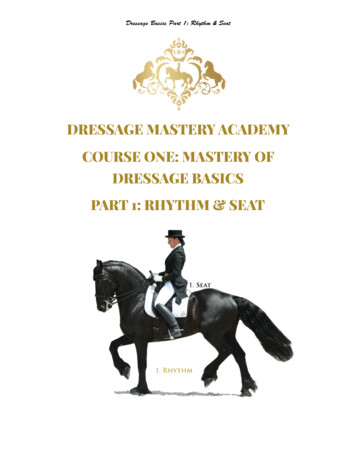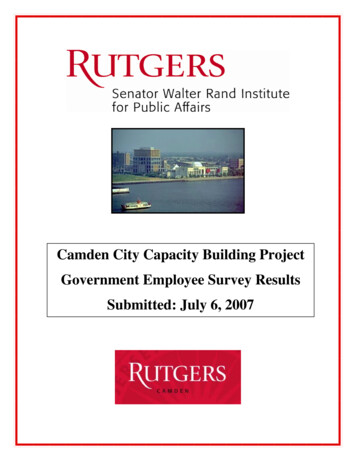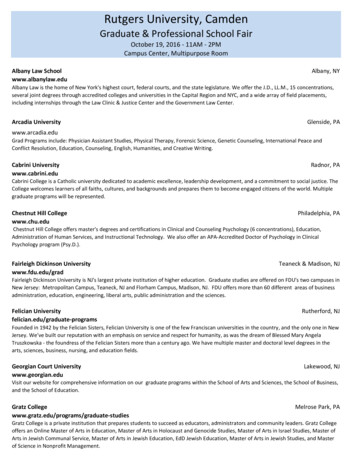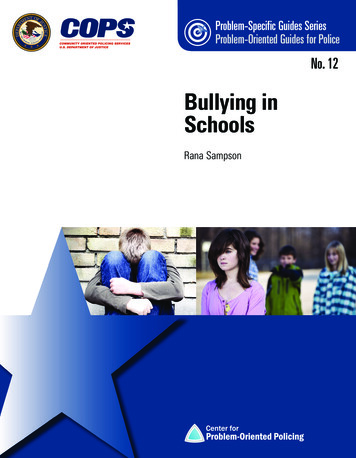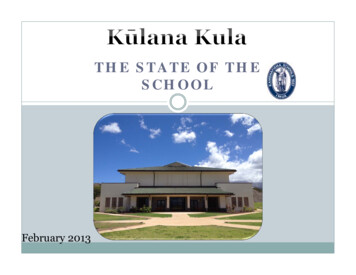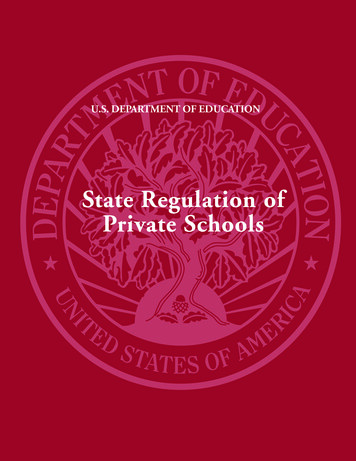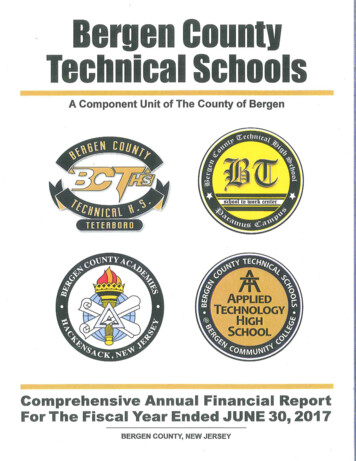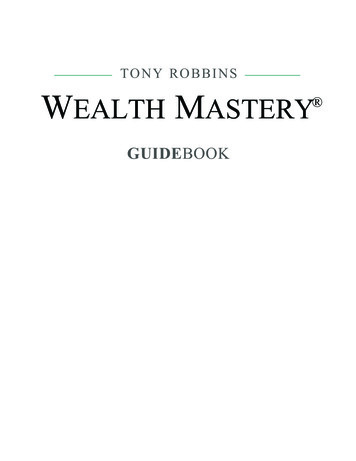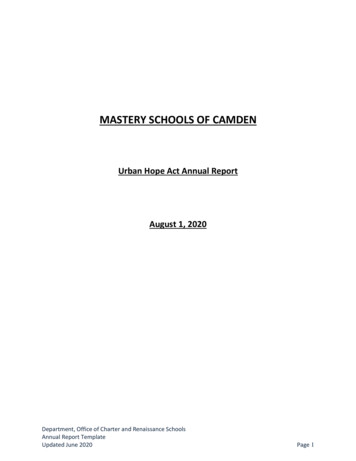
Transcription
MASTERY SCHOOLS OF CAMDENUrban Hope Act Annual ReportAugust 1, 2020Department, Office of Charter and Renaissance SchoolsAnnual Report TemplateUpdated June 2020Page 1
Table of ContentsBASIC INFORMATION . Page 31. EDUCATION PROGRAM AND CAPACITY . Page 82. SCHOOL CULTURE AND CLIMATE . Page 173. BOARD GOVERNANCE . Page 274. ENROLLMENT . Page 295. FACILITIES . Page 33Department, Office of Charter and Renaissance SchoolsAnnual Report TemplateUpdated June 2020Page 2
Annual Report Questions:Basic Information about the SchoolFill in the requested information in Table 1below.Table 1: Basic InformationName of Renaissance School ProjectMastery Schools of CamdenYear Opened2014Grade level(s) served in 2019-2020K-12Final enrollment count for 2019-2020 (asof June 30, 2020)2,625Grade Level(s) to be Served in 2020-2021K-12Projected enrollment for 2020-20212,619Mailing address5700 Wayne Avenue, Philadelphia, PA 19144Website addresshttp://www.masterynj.orgName of board presidentJim ShewardBoard president email addressjim@shewardfamily.comBoard president phone number(610) 952-1201Name of Renaissance School ProjectLead PersonScott GordonLead Person email addressScott.Gordon@Masterycharter.orgLead Person phone number267-872-8710Name of School Business Administrator(SBA)Chris BartsSBA email addressChris.Barts@Masterycharter.orgSBA phone number267-838-1313Department, Office of Charter and Renaissance SchoolsAnnual Report TemplateUpdated June 2020Page 3
School Site Information:Provide the requested information for each school location. Copy Table 2 below and fill it out for eachschool site if the school has more than one site.Table 2: School SitesSchool Site 1 InformationContent ColumnSite nameCramer Hill ElementaryYear site opened2014Grade level(s) served at this site in2019-2020K-8Grade level(s) to be served at this site in2020-2021K-8Site street address 11001 North 17th StreetSite street address 2Site cityCamdenSite ZIP08105Site phone number856-726-0027Meredith Howell-Turner (K-2);Site lead or primary contact’s nameJessie Gismondi (3-8)Meredith.Howell-Turner@MasteryNJ.org;Site lead’s email addressJessie.Gismondi@MasteryNJ.orgSchool Site 2 InformationSite nameMolina Lower ElementaryYear site opened2017Department, Office of Charter and Renaissance SchoolsAnnual Report TemplateUpdated June 2020Page 4
Grade level(s) served at this site in2019-2020K-2Grade level(s) to be served at this site in2020-2021K-2Site street address 1415 North 9th StreetSite street address 2Site cityCamdenSite ZIP08102Site phone number856-993-7004Site lead or primary contact’s nameKimberly BlakeSite lead’s email addressKimberly.Blake@MasteryNJ.orgSchool Site 3 InformationSite nameMolina Upper ElementaryYear site opened2015Grade level(s) served at this site in2019-20203-8Grade level(s) to be served at this site in2020-20213-8Site street address 1601 Vine StreetSite street address 2Site cityCamdenSite ZIP08102Site phone number856-966-8970Site lead or primary contact’s nameRickia ReidSite lead’s email addressRickia.Reid@MasteryNJ.orgDepartment, Office of Charter and Renaissance SchoolsAnnual Report TemplateUpdated June 2020Page 5
School Site 4 InformationSite nameEast Camden MiddleYear site opened2015Grade level(s) served at this site in2019-20206-8Grade level(s) to be served at this site in2020-20216-8Site street address 13064 Stevens StreetSite street address 2Site cityCamdenSite ZIP08105Site phone number856-966-5111Site lead or primary contact’s nameStephen WilliamsSite lead’s email addressStephen.Williams@masterycharter.orgSchool Site 5 InformationSite nameMastery High School of CamdenYear site opened2018Grade level(s) served at this site in2019-20209-12Grade level(s) to be served at this site in2020-20219-12Site street address 1800 Erie StreetSite street address 2Site cityCamdenDepartment, Office of Charter and Renaissance SchoolsAnnual Report TemplateUpdated June 2020Page 6
Site ZIP08102Site phone number856-966-5111Site lead or primary contact’s nameDr. William HayesSite lead’s email addressWilliam.Hayes@MasteryNJ.orgSchool Site 6 InformationSite nameMcGraw ElementaryYear site opened2015Grade level(s) served at this site in2019-2020K-5Grade level(s) to be served at this site in2020-2021K-5Site street address 13051 Fremont StreetSite street address 2Site cityCamdenSite ZIP08105Site phone number856-966-8960Site lead or primary contact’s nameCharmaine GilesSite lead’s email addressCharmaine.Giles@MasteryNJ.orgDepartment, Office of Charter and Renaissance SchoolsAnnual Report TemplateUpdated June 2020Page 7
Organizational Performance AreasEducation Program and Capacity1.1 MissionDescribe how the renaissance school project has progressed towards achieving the mission, goals, andobjectives as included in its application to the State. (Please limit your response to a 1-page maximum.)THE MISSIONAll students learn the academic and personal skills they needto succeed in higher education, compete in the global economy, and pursue their dreams.Serving the students of Camden towards our ambitious mission has meant providing robustprogramming for students with a variety of special education and English language needs. Ourprogramming is designed on an individual basis to respond to the needs of each student, to meet themwhere they are academically, behaviorally, and socio-emotionally to support them in meeting ourrigorous expectations. In addition to our academic programs, students engage in daily social-emotionallearning through community and morning meetings, in which teachers develop social skills and supportstudents in their interactions with peers and school staff. Students and families also have access to dailyaftercare services, if needed, and summer programming that provides opportunities for enrichment,homework support, and joyful activities such as arts and crafts and sports. Our summer programprioritized the needs of students in reading and math and partnered with outside organizations toprovide further enrichment. Furthermore, students experience a variety of enrichment coursesthroughout the year including Spanish, physical education, art and music - all designed to provide accessto varied coursework to prepare our students beyond Mastery. Our sports and extracurricular programsalso help ensure students have a robust and holistic experience. During the recent pandemic andclosure, our mission has never been more important and we have worked expeditiously to ensure allstudents have access to laptops, internet and the resources and supports they need to be successful.We are fully prepared to open in the fall, offering a hybrid approach as well as full online options forstudents and families that request them.1.2 Curriculuma) As Appendix A, provide a signed assurance that the renaissance school project’s curriculum isaligned to the New Jersey Student Learning Standards.See Appendix A. Mastery Schools of Camden’s curriculum is aligned to the New Jersey Student LearningStandards.b) Provide details about any planned changes to the curriculum and assessments for the 2020-2021school year. Please limit your response to a 1-page maximum.Department, Office of Charter and Renaissance SchoolsAnnual Report TemplateUpdated June 2020Page 8
Mastery’s Flexible Learning Model (FLM) is designed in recognition that the pandemic will end and a daywill come when students will fully return to classrooms, common spaces and enjoy the full amenities ofour buildings. Therefore, our programming maintains as much of our Common Foundation model asfeasible. In our FLM, when we could maintain curricula and approaches we did in an effort to ensureour teachers and leaders continue to develop familiarity and expertise and our students have acontinuity of experience. Yet, while the FLM maintains much of the Mastery model, it is also serving to“leapfrog” Mastery forward.In order to accommodate social distancing during the school day, we’re planning for 50% of students inthe building at one time. Based on feedback from families and school leaders, our lead planning postureis general education students in the building 2 days/week and learning remotely 3 days/week. We willalso provide a full distance-learning mode for students who must be remote. Students will attend schoolin the building 2 days/week and engage in distance learning 3 days/week. Every day, students receive 5hours of learning time.ProgrammingSmall GroupReading &PhonicsK-2FundationsGR - TBDLexia3-5Reading &WritingMathSocial StudiesScienceSpecials/ElectivesWheatleyEureka & dgenuityTBDMastery Unit PlansThe DBQ ProjectEdgenuity6-89-12SpringboardAgile Mind,Khan Academy,EdgenuityTeacherLesson Plans,EdgenuityAssessmentMastery will maintain its assessment cadence (quarterly benchmarks, checkpoints, daily exit tickets,etc.). MAP will be administered in late Sept/Oct. We are moving full steam ahead with our Illuminateadoption and will use this to leapfrog towards full/phased-in online testing. However, in response to thenew Flexible Learning Model, the following changes are proposed to give schools the time and resourcesneeded to adopt new assessments and roll-out online testing at their schools.Assessment1. Transition to Online Assessments: Phase in the use of online assessments during the schoolyear so all students have access to assessments regardless of whether they are in classroomlearning mode or distance learning mode. We will transition by adopting online assessments forELA and Math in RP1, and use flexible assessments (i.e. digital version of PDF booklets andanswer sheets) for all other subjects.2. Change MAP Administration Dates: Shift the start of MAP Growth testing by two weeks to9/14, extend the window to 21 days, and close administration on 10/13. We held multiple talkswith NWEA, the creators of MAP, and feel that the only way to ensure we can obtain the datawe need is to administer the tests in school.3. Change Benchmark Administration Dates: Shift the RP1 benchmark window by one week tostart on 10/26, extend it to be two weeks total, and close BMs on 11/6. Shifting the testingDepartment, Office of Charter and Renaissance SchoolsAnnual Report TemplateUpdated June 2020Page 9
window gives schools an extra week they can use flexibly as we transition into the FLM in RP1,and extending the window ensures that schools will have the staffing resources needed toexecute proper online testing.4. Adopt MAP Reading Fluency: Add MAP Reading Fluency as the K-2 assessment of record. Thenetwork will use this assessment to set annual goals, KPIs, and adjust instructional practice.5. Add a Screening Window: to ensure uniformity and data quality, add a beginning of the yearassessment screening window for all placement and diagnostic assessments.1.3 Instructiona) What constitutes high quality instruction at this school?Mastery describes and defines high quality instruction through our Instructional Standards. TheInstructional Standards are a compilation of best teaching practices, successful teacher traits, andcommon measures of student success. Each standard is designed to create an effective, rigorous andjoyful classroom experience that will serve to prepare students for post-secondary success, theglobal economy, and the pursuit of their dreams. There are five Instructional Standards:1. Student Achievement: The degree to which students master the content, grow academically andachieve.2. Content Engagement: The degree to which students are brought into and actively navigate theiracademic experience.3. Supportive Community: The degree to which students participate in, support and enrich theacademic experience of their classmates.4. Lesson Design and Facilitation: The degree to which the teacher designs and facilitates a lessonthat moves all students forward academically.5. Motivation, Relationships & Classroom Management: The degree to which the teachermotivates, builds mindset and creates a supportive classroom community.The Instructional Standards serve as the pedagogical basis for teacher reflection, coaching,professional development, and evaluation. Our Instructional Standards are our vision for excellentteaching and serve as the basis for our teacher development and evaluation. Teachers, schoolleaders and teacher coaches use the Instructional Standards to define strengths and opportunitiesto further teacher practice.b) Provide a brief description of the school’s instructional practices.Our instructional program is rooted in balancing direct instruction with a conceptual approach, to attendto the demands of the NJ state standards. Our program ensures we meet students where they are inorder to support them with achieving the rigorous bar set by the NJSLA assessments. As such, all of ourprogramming offers our students multiple experiences to ensure they are both growing and improvingagainst the grade level bar. We balance all of our instruction with a culture of joy, play and enrichingexperiences that meet the holistic needs of our learners.Department, Office of Charter and Renaissance SchoolsAnnual Report TemplateUpdated June 2020Page 10
LiteracyMastery believes the foundation of student achievement is reading. The National Research Councilfound that “Academic success, as defined by high school graduation, can be predicted with reasonableaccuracy by knowing someone’s reading skill at the end of 3rd grade.” With this in mind, one of ourmost important priorities is to develop all teachers as exceptional reading instructors, employing bestpractices in reading instruction.Mastery’s early reading program is purposefully designed to meet students’ needs in terms of decoding,comprehension, fluency, vocabulary and writing. At the K-2 level, Mastery dedicates 180 minutes toliteracy instruction through a balanced approach that includes guided reading, phonics instruction, andour KIPP Wheatley standards-aligned reading and writing program. Fundations is the curriculum that weuse for phonics instruction- all K-2 students receive at least 30 minutes/day of systematic instruction tobuild their foundational reading skills.K-2 classrooms also have a higher teacher to student ratio wheremost classrooms have a Literacy Support teacher that provides additional support: this allows our staffto provide targeted interventions to struggling readers and provide differentiated instruction to meetunique student needs.In grades 3-8, we use the KIPP Wheatley curriculum as our ELA curriculum, which includes reading,writing and support components. Wheatley includes close reading lessons with complex texts focusedon building students’ skills to deeply understand what they are reading as well as building knowledge.Through Wheatley writing lessons, students learn explicit frameworks for constructing narrative,explanatory, and argumentative writing products that draw on the essential themes and unique featuresof the texts students are reading. Through an additional Literature Centers block, teachers spent timewith students on students’ instructional levels to support reading growth through Guided Reading,independent reading, anchor novel support, and remediation.At the high school level for grades 9-12, Springboard serves as our ELA curriculum. Springboard is acomplete instructional program that prepares students for college-level work. It includes texts, dailyobjectives, checks for understanding, daily lesson assessments and end of unit assessments that arealigned with the rigor of the NJ learning standards and NJSLA and will provide formative and actionabledata to drive instruction.Throughout the K-8 program, students’ reading is assessed in several important ways. First, we use theFountas and Pinnell Benchmark Assessment System for all students in grades K-2 and for our specialeducation students in our other grade levels to constantly measure student reading levels on an A-Zcontinuum in order to identify specific strengths and weaknesses. Second, students take NJSLA-alignedcheckpoint assessments twice per quarter and quarterly benchmark assessments that align with ourWheatley curriculum modules every 8-10 weeks beginning in third grade. These assessments are used atthe primary tool for teacher planning and instructional delivery in grades 3-8. We also take a similarapproach to quarterly ELA benchmark assessments in grades 9-12 that aligns with our Springboardcurriculum as well. Third, we administer the NWEA MAP (Measures of Academic Progress) assessmentto the fall, winter and spring to assess student growth over time. MAP provides valuable data to leadersand teachers to inform data-driven instruction to be responsive to the needs of individual learners.MathDepartment, Office of Charter and Renaissance SchoolsAnnual Report TemplateUpdated June 2020Page 11
Eureka Math is our K-8 math program and focuses on several guiding principles to support strong mathinstruction in the classroom:Our approach to math instruction is to provide students with authentic experiences learning aboutnumbers and how they work by way of investigation with the use of manipulatives and sharing theirlearning by engaging in robust discussions.Students share their thinking about how to solve problems and learn from other students in the process.In the Eureka program, students learn grade-level content, as defined by the NJ learning standards andNJSLA, by engaging in aligned fluency routines, high-quality tasks, problem sets, class discussions, andmathematical models to explore mathematical concepts and skills. Students solidify their learningthrough extended application, practice of the mathematics and the lesson debrief.Agile Mind is the core resource for High School Algebra courses at Mastery High School of Camden forgrades 9-12, and focuses on four areas of student preparation:1. Cohesion – The common-core aligned curriculum used within these curricula prepares students forthe rigors of NJSLA2. Rigor – A balance of procedural and conceptual understanding within the curricula ensures thatstudents are actively preparing for advanced study in mathematics3. Critical Thinking – These curricula regularly incorporate real-world application opportunities groundedin the Standards for Mathematical Practice in order to build the critical thinking skills needed for postsecondary success.4. Remediation - The Intensified Algebra curriculum is used in 9th and 10th grade to ensure that allstudents are provided a comprehensive research-based intervention to address unfinished learningwhile simultaneously engaging with grade-level content in preparation for NJSLA and post-secondaryreadiness.c) Describe how the school adapted to the delivery of remote instruction? What areas of strengthand areas of opportunity were identified?The goal of Mastery’s continuity of education plan was to provide opportunities for all of our students toengage in academic enrichment and review as well as planned instruction during school closures due toCOVID-19. At Mastery, the plan was termed “Home Academic Practice” (HAP) and we defined this asdaily independent and parent-supported practice and review opportunities coupled with new lessonsdesigned to keep students academically engaged during school closure. In step with the evolvingpandemic, there were three phases to HAP, each unveiled as we received clearer information from thestate about the remainder of the school year.The first phase, which covered the second half of March immediately following school closure, consistedof direction and guidance provided to students and families for reading and self-directed online learningin math and reading on Mastery-se
Name of School Business Administrator (SBA) Chris Barts . students have access to laptops, internet and the resources and supports they need to be successful. . Mastery’s Flexible Learning Model (FLM) is designed in recognition that the pandemic will end and a day
